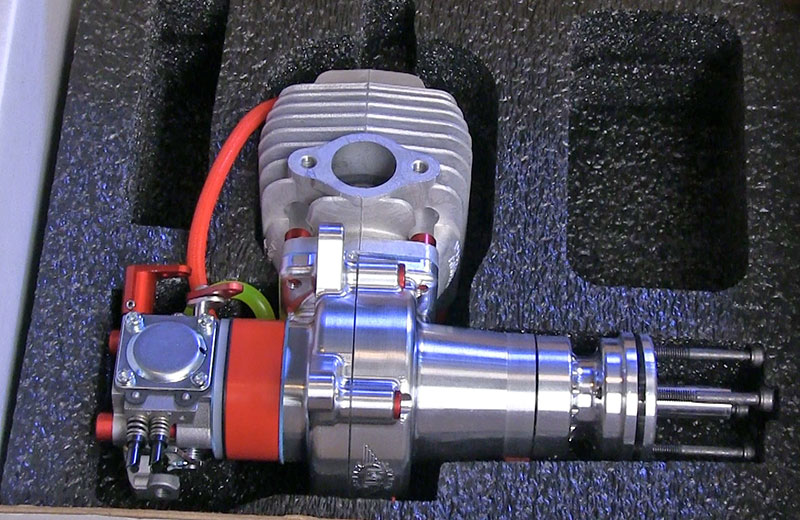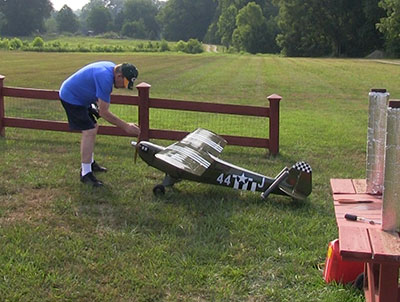



It frustrates me when I use something I was not sure of only to be forced to do the right thing, in this case use
a DA35 engine. Life has been sweeter ever since.
Text, photos and video by Tom Hintz
Flight video by Mike Basmajian
Posted - 7-31-2018
When the original engine in my L-4 Grasshopper morphed into an expensive boat anchor I decided to go to the other end of the spectrum. I installed a DA-35 Gas Engine I already had in the shop but had not been able to fly more than a few times. This DA-35 Gas Engine isn’t close to being broken in, but the L-4 Grasshopper is a terrific platform to help the engine come of age, so to speak.
Planes like the L-4 Grasshopper that have a true-to-scale, short nose often need a considerable lump of lead in the front to balance properly. Complicating this somewhat is that installing the DA-35 Gas Engine removes ½-pound from what the previous 35cc engine weighed. Rather than piling on the lead until it balanced I spent some time using other methods to minimize the overall amount of additional weight needed.
Situations like this are where my penchant for a pair of Glacier 7.4V, 5000mAh (each) LiPo’s pay off. I moved both of those packs to the bay just behind the lower firewall. Moving existing equipment/components forward maximizes their influence on the CG which is cheaper and can result in a noticeably reduced overall weight.
I found my “heavy hub” that was used on an old warbird and added that to the DA-35 Gas Engine. It weighs several ounces but mounted on the end of the DA-35 Gas Engine crankshaft uses the maximum leverage possible on the L-4 Grasshopper to increase its effect on the CG.
In the final balancing I had to add 8-1/4-ounces of lead to the firewall to achieve neutral balance on the recommended CG. Note that the original instructions for the L-4 Grasshopper suggested up to 19-1/2-onces of ballast might be needed! It is not uncommon for people to add a bit more weight to make a plane like this somewhat nose heavy which softens elevator response. I like a neutral or a slightly rearward CG. It’s just a personal preference. My best advice on CG in the is to start where the instructions specify. Then, if you want to change the CG do it in small increments!
The only “compromise” that I needed to make with this conversion was to open the cowl more across the bottom. Changing from a cheek-style muffler on the previous engine to a Pitts on the DA-35 Gas Engine means a bigger hole. That’s not always a bad thing as we need roughly three times the air exit as the air inlet for proper cooling. Anyway, its on the bottom and I can just “not look” for now. I’ll eventually get a new cowl once I know that no further modifications will be needed on the L-4 Grasshopper.

One of the benefits of the DA35 was not fighting the
starting procedure.
It should come as no surprise that the DA-35 Gas Engine hauls the L-4 Grasshopper around the sky with ease. The L-4 Grasshopper seems to like takeoff to begin with going to full power rather than rolling the power on. Going right to full power causes very little wandering left or right, the tail to jump off the ground, and it reaches safe takeoff speed in 20 feet or so. This isn’t a plane/engine combination that allows one to go vertical after leaving the ground but there is plenty of power to fly away from the takeoff with authority even in rather stiff winds.
I had wondered if the lack of flaps (spoiled by my 30cc Valiant) on the L-4 Grasshopper would cause takeoff or landing issues but that has not occurred in any of the wind conditions in which I have flown. The L-4 Grasshopper wing is thick and nicely shaped to produce gobs of lift down to surprisingly slow speeds. The DA-35 Gas Engine runs so well just above an idle that I can control or extend the sink easily to land where I want easily. It is also easy to keep the tail “flying” as the L-4 Grasshopper rolls down the runway after landing. When I get into my incessant touch-and-goes, the DA-35 Gas Engine transitions from low to high speed without delay.
The L-4 Grasshopper really isn’t a speed platform but with the DA-35 Gas Engine it is faster than I anticipated. The wing is thick, and I thought might be producing too much lift at speed as the L-4 Grasshopper tended to balloon at full throttle in the first flights. I then found myself having to hold more up elevator than I like during throttle-off approaches to the runway.
On the advice of a friend I added a normal washer under both upper engine mounts to add a bit of down thrust. That did the trick. The L-4 Grasshopper can now be easily trimmed for high throttle straight and level flight but then goes into a smooth, controllable sink in preparation for landing with no further trim changes. I’m sold.
One of the things I like about high-wing planes like this is the response to rudder input. I love sliding the L-4 Grasshopper around to set up for landing, something that is handy in windy conditions where keeping the wing level to the ground is a safer idea than even a moderate bank.
The L-4 Grasshopper is also comfortable at what appears to be a drastic-looking side-slip as it flies past the flight line. A little cross control (rudder/elevator, sometimes a bit of aileron) with a little throttle and the L-4 Grasshopper sort of slides down the flight line looking like it is about to fall out of the sky.
I did get to find out how slow the L-4 Grasshopper had to go to fall out of the sky on day one with the new engine. On a takeoff the right wheel stayed on the ground as the rest of the L-4 Grasshopper took off. I thought I could land the L-4 Grasshopper a bit slower than normal and be able to hold the right wing up until it just didn’t have enough speed to fly. The problem was I had not yet experimented to see how slow the L-4 Grasshopper could go. It was going sort of slow when it just decided that was enough and it plopped on the ground. The wheel-free side dug in and the L-4 Grasshopper stopped all at once. Aside from some dirt in the bolt under the right-side gear there was no damage. Even the Vess prop survived unharmed. A new bolt and some thread locker and the L-4 Grasshopper was back in the air and doing my touch and go thing the rest of the day.
The L-4 Grasshopper and DA-35 Gas Engine make a great every day flier combination. The L-4 Grasshopper looks great in the air, making it a solid war bird meet plane to have fun with. The handling is predictable, and the controls remain solid-feeling right down to a ridiculously slow airspeed.
The DA-35 Gas Engine provides plenty of power but more important to me is the reliability and smooth transitions. The DA-35 Gas Engine is one of the most popular engines in RC flying with good reason. It produces more power than most and is lighter at the same time, in my case here, by half-a-pound. That is significant in a RC plane. Less weight almost always translates to better handling which in the case of the L-4 Grasshopper makes it a great plane to have fun with at warbird meets and every other weekend between those events.
See the original L-4 Grasshopper Review – Click Here
Have a comment on this Update? –Email Me!